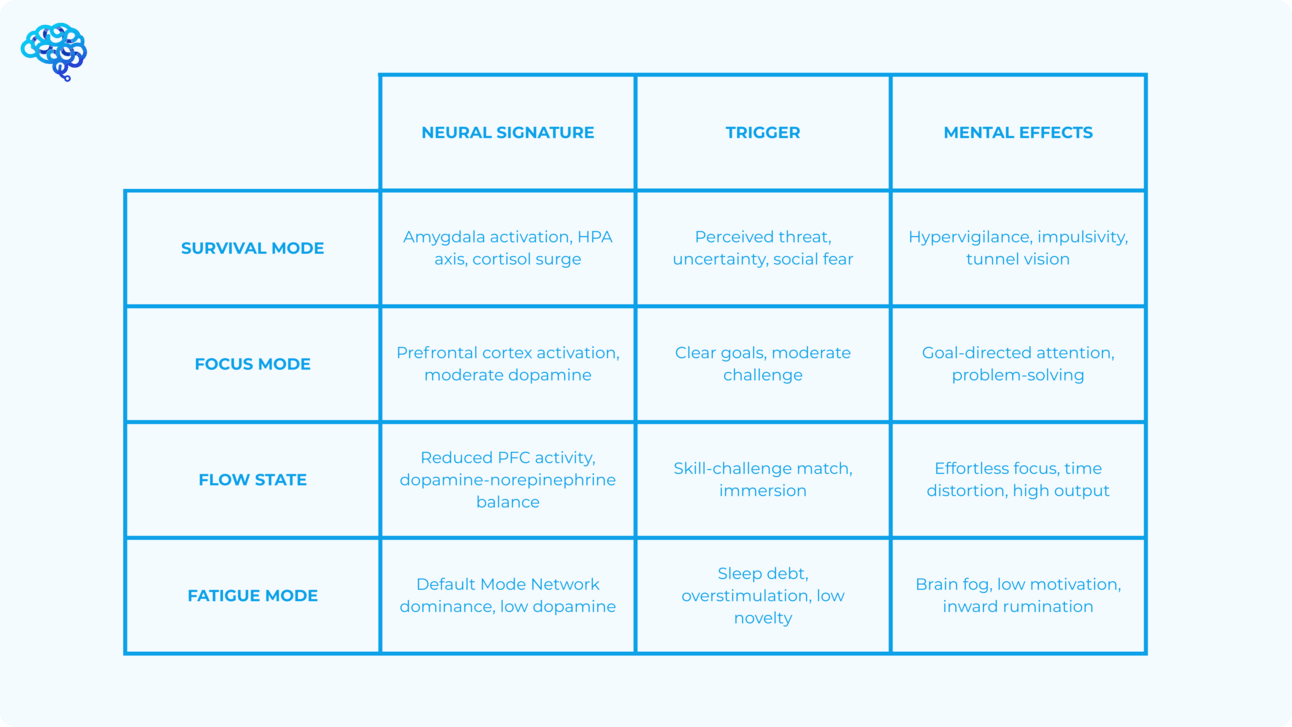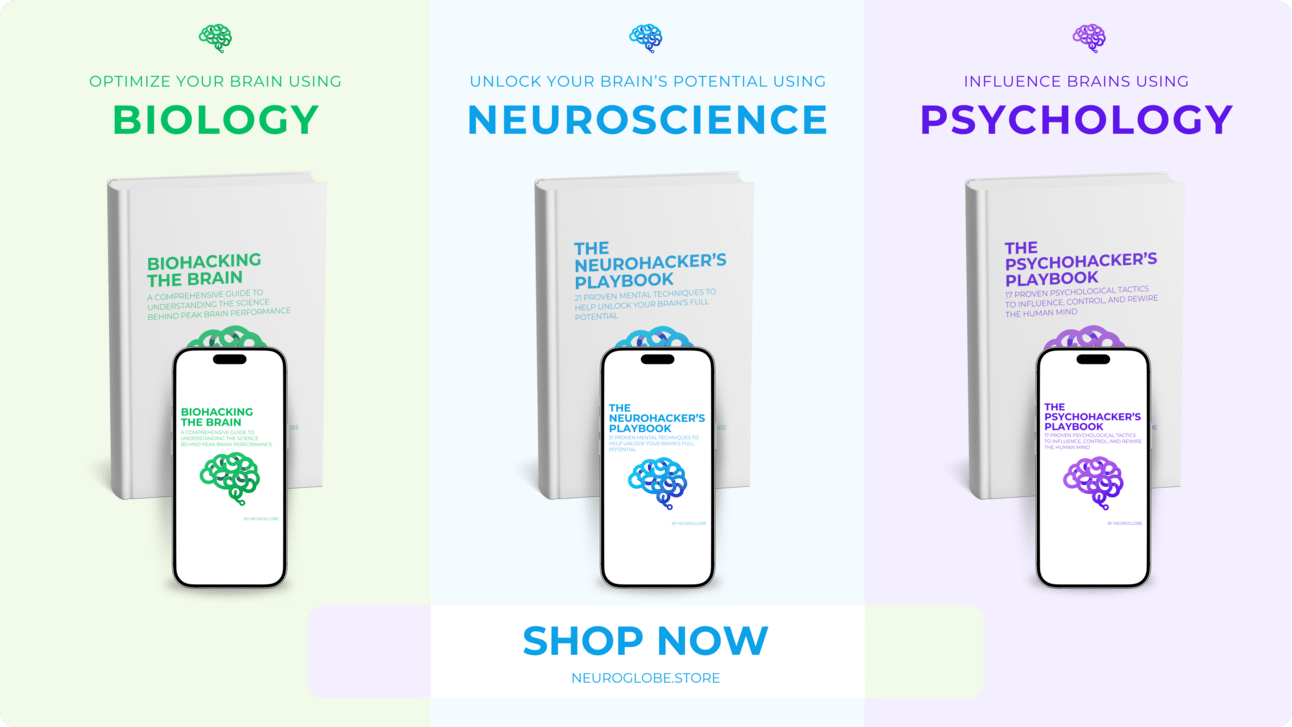- Neuroglobe Brain Health
- Posts
- The Neuroscience of Brain States
The Neuroscience of Brain States
How your brain shifts between modes, and how to take control of the switch.
Welcome to Another Neuroglobe Original
Your brain isn’t always operating in the same mode. It shifts between distinct functional states, each with its own chemistry, circuitry, and behavior. In this post, we break down the neuroscience behind those shifts, and how to take control of them.
What Are Brain States?
Your brain is never neutral, it’s always operating in a specific state: a dominant pattern of neural activity that shapes how you think, feel, and act. These states aren’t moods or personality traits, they’re functional modes driven by shifting levels of neurotransmitters, electrical rhythms, and environmental input. Each state prioritizes certain behaviors while suppressing others. Understanding them is the first step toward controlling them.
The Four Core Brain States
Your brain doesn’t stay in one fixed mode, it shifts between states depending on what it perceives, needs, or expects. These shifts aren’t random. They’re biological strategies shaped by evolution and fine-tuned by context.
Here are the four core states that dominate most mental activity:

Each of these states is adaptive, but only when matched to the right situation. Problems arise when you're stuck in the wrong one.
How the Switch Works
You don’t consciously choose your brain state—your brain does. Each shift is driven by internal chemistry and external input, activating specific neural circuits based on what the brain perceives as most adaptive in the moment.
The core drivers behind these transitions are:
Neurotransmitters
Cortisol signals threat and pushes the brain into survival mode, heightening vigilance and reactivity.
Dopamine facilitates focus and flow, especially when there's a clear reward or novelty.
Norepinephrine modulates alertness and arousal—too little leads to fatigue, too much to panic.
Brain Region Activation
The prefrontal cortex (PFC) enables executive control and goal-setting—central to focus mode.
The amygdala triggers fast emotional responses—central to survival mode.
The Default Mode Network (DMN) becomes dominant during fatigue, daydreaming, or mental drift.
External Inputs
Threat, unpredictability, or social evaluation? → Survival mode.
Clarity, novelty, and challenge? → Focus or flow.
Overstimulation or boredom? → Fatigue.
Once a state is active, it tends to resist change—this is called state inertia. The longer you're locked into a state, the more the brain defaults to it. This is why anxious people stay anxious, and burned-out people stay foggy. It’s not willpower—it’s neurobiology.
How to Influence the Switch
You can’t stop your brain from shifting states, but you can learn to guide it. Most transitions happen automatically. But there are a few that are both scientifically supported and worth mastering, because they directly affect your ability to perform, recover, and stay mentally clear.
Here are the three switches you can influence with precision:
Survival → Focus
When the brain perceives threat, it enters survival mode—fast, reactive, and tunnel-visioned. To shift out, the brain needs cues of safety and stability.
Use deep, slow breathing (especially longer exhales) to activate the parasympathetic nervous system.
Ground yourself through physical touch, eye anchoring, or environmental cues like nature or stillness.
Simplify your tasks—structure calms the cognitive system.
Focus → Flow
Focus is controlled. Flow is automatic. The key to transition is removing friction while keeping pressure.
Match the difficulty of the task to your skill level. Slightly too hard is ideal—it stimulates norepinephrine and dopamine.
Create time blocks free from interruptions.
Use a clear entry ritual—same place, same start signal—to tell the brain it’s time to drop in.
Fatigue → Recovery
When you’re stuck in fatigue, stimulation won’t fix it. Your nervous system needs to reset, not push.
Prioritize morning sunlight and a consistent sleep window to anchor your circadian rhythm.
Use non-sleep deep rest protocols, slow movement, or cold-to-warm contrast to restore balance.
Reduce novelty—fatigued brains benefit from repetition and quiet.
These are the three state transitions worth mastering. Others happen too, but they’re less controllable, and usually not productive. Learn to drive these switches, and your brain will start working for you, not against you.
FAQs
Are brain states the same as emotions?
No. Emotions are momentary responses, brain states are broader modes of neural function. A state like survival mode might include fear or anxiety, but it also involves specific patterns in brain activity, attention, and behavior. Emotions are signals. Brain states are systems.
Can I be in more than one brain state at once?
Not exactly, but states can overlap during transitions. Your brain typically operates in one dominant state at a time, based on what it perceives as most adaptive. That said, you can have residual activity from a previous state (e.g., residual tension from survival mode while trying to focus).
Why do some people seem “stuck” in a single brain state?
This is due to state inertia, once a neural pattern is reinforced repeatedly (like chronic stress), the brain starts defaulting to it. Over time, the brain becomes more efficient at entering that state, even when it’s no longer appropriate. Rewiring this requires disrupting the pattern and creating consistent inputs for a new state.
Final Thoughts
Mastering your brain doesn’t mean staying in one state, it means learning to move between them with intention.
If you're serious about optimizing your cognitive performance, check out our bestselling ebooks for more science-backed strategies.
Stay sharp,
Neuroglobe Team

